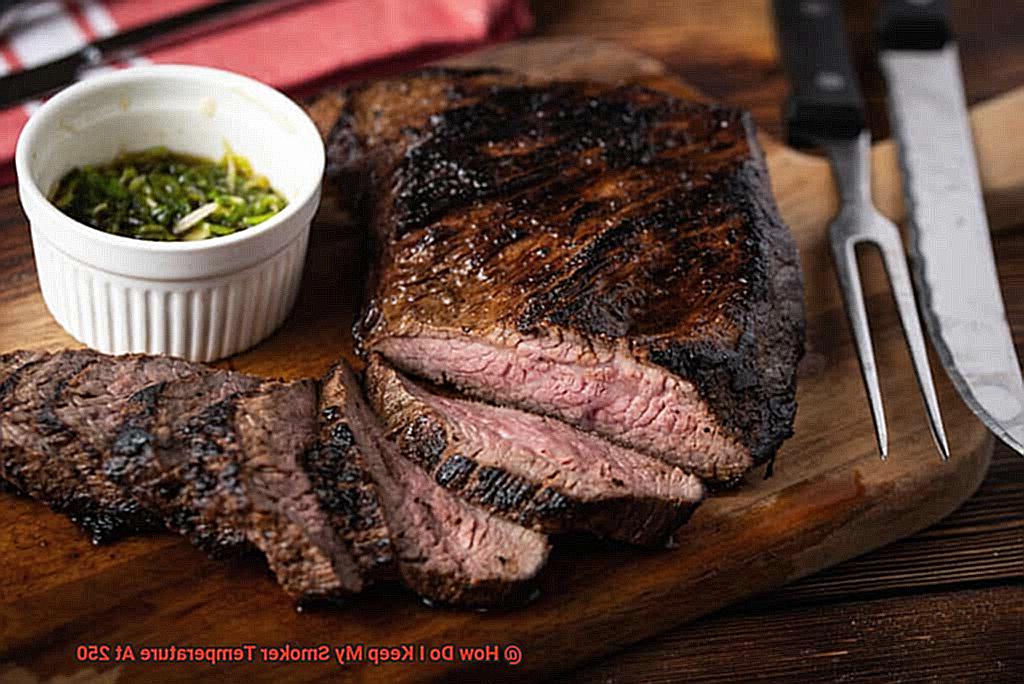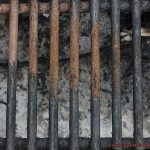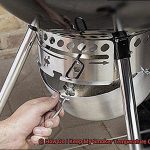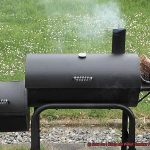Do you find yourself frustrated with your meats turning out either undercooked or burnt when you attempt to smoke them? Consistency in temperature is the key to achieving that perfect BBQ flavor in your meats. In the world of smoking meat, temperature control reigns supreme. Whether you’re a seasoned pro or new to the game, getting the temperature right is critical. If you want your meat cooked perfectly, then complete control over your smoker’s temperature is crucial. So, if you’re wondering how to keep your smoker temperature at 250 degrees Fahrenheit, then read on.
In this post, we’ll be discussing some of the best ways to ensure that your smoker remains at a steady 250 degrees Fahrenheit throughout the cook. From essential equipment to simple yet effective tips and tricks, we’ve got you covered. By the end of this article, you’ll have all the necessary knowledge and skills required to keep your smoker at 250 degrees Fahrenheit and elevate your BBQ game. Whether it’s pork shoulder, ribs, chicken or brisket – get ready for mouth-watering smoky goodness.
So, let’s dive in and explore how to master that perfect temperature control.
Contents
Choosing the Right Smoker for Temperature Control
When it comes to smoking meat, temperature control is a key factor that can make or break your dish. Different types of smokers offer varying levels of temperature control, so choosing the right one for your needs is crucial. Let’s explore the differences between electric, gas, and charcoal smokers in terms of maintaining consistent temperatures.
Electric Smokers
If you’re looking for precision in temperature control, electric smokers are a great option. With digital controls, you can easily set and adjust the temperature to your desired level. Electric smokers require minimal effort to maintain a consistent temperature, making them a hassle-free option for beginners or those seeking ease of use.
Gas Smokers
Gas smokers are another popular choice for maintaining temperature control. These smokers come equipped with built-in thermostats that allow you to set and maintain your desired temperature. They heat up quickly and are easy to operate, making them a convenient option for grillers seeking speed and convenience.
Charcoal Smokers
While charcoal smokers can be more challenging when it comes to maintaining temperature control, they offer exceptional flavor when done correctly. The key to achieving consistent temperatures with a charcoal smoker is using the right amount of charcoal and adjusting the airflow accordingly. With some practice and experience, you can achieve great results, making it a worthwhile option for those willing to put in extra effort.
Additional Tips for Temperature Control
No matter what type of smoker you choose, there are additional tips that can help you maintain consistent temperatures. Using a digital thermometer with a probe will allow you to monitor the temperature accurately and make adjustments as necessary. Adjusting the vents on your smoker can also help regulate airflow and temperature. Adding water to your setup can help prevent meat from drying out while cooking and regulate the cooking environment.
Using a Digital Thermometer to Monitor Temperature
As an avid smoker, you understand that getting the temperature right is the key to mouth-watering meat. However, maintaining the right temperature is not always easy, and that’s where a digital thermometer comes in handy.
Using a digital thermometer to monitor and control the temperature of your smoker is one of the best ways to get the perfect cook. It provides a more accurate reading of the temperature inside the smoker compared to a built-in thermometer that can be off by several degrees.
But how do you use it properly? The first step is to place the probe in the thickest part of the meat, making sure it doesn’t touch any bones or other parts of the meat. This ensures an accurate temperature reading.
Once inserted, set your desired temperature alarm- let’s say 250 degrees Fahrenheit – and wait for the alert. This alert lets you know when the meat has reached the desired temperature, allowing you to adjust your smoker’s temperature as needed to maintain a consistent cooking temperature.
But why stop at just monitoring your meat? Get a digital thermometer with wireless capabilities and monitor both your meat and smoker temperatures from a distance. This feature comes in handy when you need to step away from your smoker or when cooking multiple items at once.
Using a digital thermometer is essential for maintaining a consistent and accurate temperature in your smoker. This ensures that your meats are cooked to perfection every time. Who doesn’t want perfectly cooked meat?
Adjusting Vents for Temperature Regulation
As any seasoned smoker knows, the perfect temperature is key to achieving that succulent, smoky flavor in your meat. And while a digital thermometer is a vital tool in your arsenal, adjusting the vents is what truly separates the novice from the master. Let me guide you through the process of adjusting vents to regulate the temperature of your smoker.
First things first: smokers have two types of vents, intake and exhaust. The intake vents are found at the bottom of the smoker, while exhaust vents are located at the top. These vents control airflow, which directly impacts the temperature inside your smoker.
When aiming for a temperature of 250 degrees Fahrenheit, begin by opening both intake and exhaust vents fully. This will allow maximum airflow and speed up the heating process. Once you reach your desired temperature, gradually adjust the vents in small increments until you find that sweet spot.
If your smoker is too hot, try closing down the intake vent slightly to reduce the amount of oxygen that enters your smoker. This will lower the temperature. Conversely, if it’s too cool, open up the intake vent slightly to allow more oxygen into your smoker and increase the temperature.
But here’s the kicker: adjusting vents isn’t an exact science. External factors such as wind conditions, humidity, and outside temperature can all affect how well your smoker maintains its temperature. So keep a close eye on your smoker and be ready to make adjustments as needed.
In summary, adjusting vents is a crucial step in regulating the temperature of your smoker. By mastering this technique, you can achieve and maintain a steady temperature of 250 degrees Fahrenheit for mouthwatering results. Remember that practice makes perfect – experiment with different vent settings until you find what works best for you. Happy smoking.
Adding Water to Maintain Moisture Levels
In our previous section, we discussed the importance of regulating the temperature of your smoker at 250 degrees Fahrenheit. However, maintaining the perfect temperature is not enough to ensure that your meat stays moist and juicy during the smoking process. To achieve this, adding water to maintain moisture levels in your smoker is crucial.
Why is water so essential for smoking meat? Smoking involves cooking meat low and slow over a long period, which can cause it to dry out if not properly hydrated. Adding water helps regulate the temperature and adds moisture to prevent your meat from becoming dry.
Now, let’s dive into the specifics of how to add water to your smoker. There are two ways: placing a water pan directly on top of the heat source or placing it on the cooking grate next to your meat. Both methods work well, so choose the one that works best for you.
When adding water, be mindful not to add too much or too little. Adding too much can lower the temperature of your smoker, while adding too little can cause your meat to dry out. A good rule of thumb is to fill your water pan halfway with hot water before placing it in your smoker.
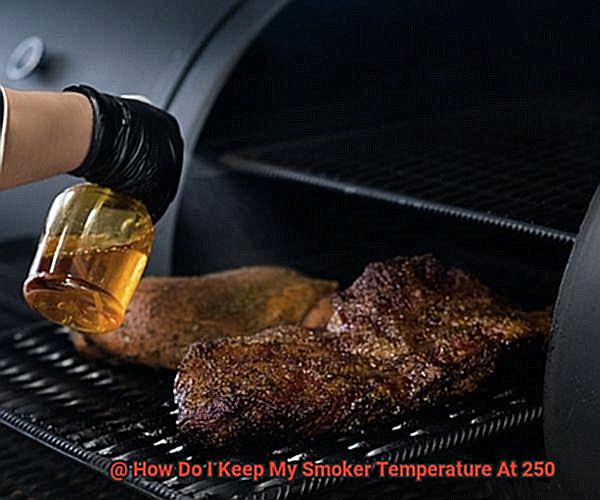
It’s also important to consider the type of water you use in your smoker. Distilled water is recommended because it doesn’t contain any minerals or chemicals that could affect the taste of your meat. Additionally, keeping a consistent water level in your pan throughout the cooking process is crucial. Check on it periodically and add more hot water as needed.
One added benefit of adding water to your smoker is that it creates a steam effect that enhances the flavor of your meat. As the water evaporates, it infuses your meat with flavor, particularly when using rubs or marinades.
To sum up, adding water to maintain moisture levels in your smoker is an easy and effective way to keep your meat from drying out while enhancing its flavor. Remember to use distilled water, fill your pan halfway, and keep an eye on the water level throughout the cooking process. With these tips in mind, you’ll be able to smoke mouthwatering, juicy meat like a pro. Happy smoking.
Tips and Tricks for Maintaining Consistent Temperature
When it comes to smoking meat, maintaining a consistent temperature is crucial for achieving the perfect flavor and texture. Here are five tips and tricks to help you maintain a steady 250-degree temperature in your smoker.
Choose the Right Fuel
Different types of wood produce different levels of heat and smoke, so it’s essential to choose the right fuel for your smoker. Hardwood lump charcoal is an excellent choice as it burns evenly and produces less ash, which can block airflow and cause temperature fluctuations.
Insulate Your Smoker
Proper insulation is key to maintaining consistent temperature in your smoker. A high-quality smoker with proper insulation will hold heat better than a poorly insulated one, making it easier to keep the temperature steady.
Watch Out for Wind
Wind can quickly cool down or raise the temperature of your smoker, leading to inconsistent cooking. Position your smoker in a sheltered area or use a windbreak to protect it from strong gusts.
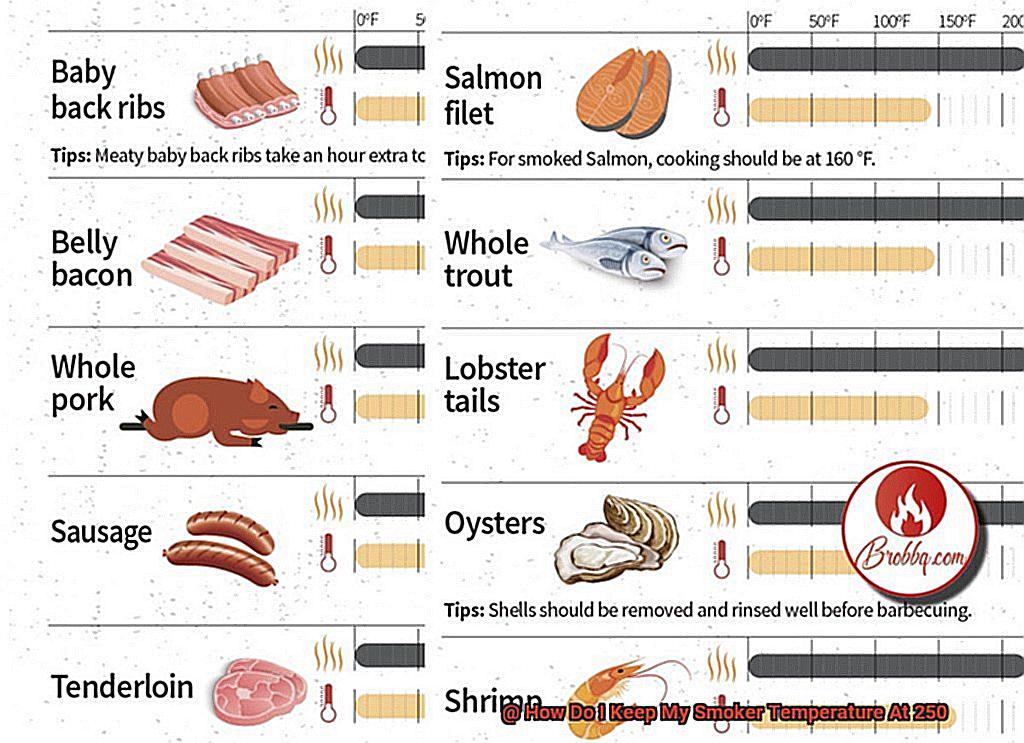
Adjust Your Vents
The vents control the amount of oxygen that enters the smoker, which affects the combustion rate and temperature. Adjusting the vents can help you maintain a consistent temperature in your smoker by controlling the amount of air that enters and exits the smoker.
Avoid Unnecessary Lid Openings
Every time you open the lid of your smoker, you let out heat and smoke, which can disrupt the temperature inside the smoker. Only open the lid when necessary, such as when you need to add more fuel or check on your meat.
Managing Fuel Sources for Accurate Temperature Readings
This task can be challenging without managing your fuel source properly. In this post, we’ll share some tips on how to manage your fuel source for accurate temperature readings in your smoker.
Firstly, selecting the right kind of fuel is crucial. Different types of fuel burn at different rates and produce different amounts of heat. Experiment with various fuels such as wood chips, pellets, or charcoal to find what works best for your smoker and desired temperature. For instance, hardwood charcoal burns hotter and longer than briquettes while hickory wood chips produce a stronger smoky flavor than applewood chips.
Once you’ve selected your fuel type, it’s essential to measure the amount you’re using. Too much fuel can cause the temperature to spike and too little can cause it to drop. The ideal amount of fuel varies with the size and type of your smoker, but a general rule of thumb is to use 1-2 handfuls of wood chips or chunks or about 1-2 pounds of charcoal per hour.
Finally, how you use your fuel can significantly affect the temperature inside your smoker. Placing wood chips directly on top of hot coals will create a burst of smoke and heat, but it quickly dissipates and causes a temperature drop. Alternatively, consider placing your wood chips in a smoker box or wrapping them in foil and poking holes in the foil to allow smoke to escape slowly over time.
Troubleshooting Common Problems with Smoker Temperatures
Fear not, as an expert in troubleshooting common problems with smoker temperatures, I have the perfect solution for you. Let’s dive into some tips to help you achieve a consistent temperature and savory smoked meats.
Evaluate Your Environment
One of the most common factors that cause temperature fluctuations is the environment. Windy conditions can be a real problem and affect the smoker’s ability to maintain a steady temperature. To combat this, it’s vital to find a sheltered area or use windbreaks to protect the smoker from gusts. Additionally, high humidity can affect the amount of heat that reaches the meat. So, using a dehumidifier or choosing a dry day to smoke can help maintain a steady temperature.
Choose the Right Fuel
Another factor that can impact smoker temperature is the type of fuel being used. Different types of wood or charcoal burn at different rates and temperatures. Therefore, it’s essential to choose a fuel source that matches the desired temperature range. For example, hardwood burns hotter and longer than softwood, while lump charcoal burns hotter and faster than briquettes. Importantly, smokers need to make sure they are using enough fuel and that it is evenly distributed throughout the smoker.
Check for Mechanical Issues
Sometimes, mechanical issues may be causing temperature fluctuations. Smokers should check for leaks in the smoker door or vents and make sure they are properly sealed. They should also clean any ash or debris from the smoker and ensure that air is flowing freely through the smoker to prevent hot spots.
NGucNJ67_wg” >
Conclusion
In conclusion, the key to achieving that perfect BBQ flavor lies in maintaining a consistent temperature while smoking meat. Whether you’re a seasoned pitmaster or a newbie, nailing the right temperature is critical for success. And it all starts with choosing the right smoker.
Electric smokers offer pinpoint precision in temperature control, gas smokers are convenient and straightforward to operate, while charcoal smokers deliver exceptional flavor when done correctly. But regardless of your preferred type of smoker, there are some universal tips and tricks to keep that temperature steady at 250 degrees Fahrenheit.
Firstly, invest in a digital thermometer with a probe to monitor your smoker’s internal temperature accurately. Secondly, adjust your vents to regulate airflow and maintain an even cooking environment. Thirdly, adding water to your setup can help prevent meat from drying out while cooking and keep the cooking environment stable.
Managing fuel sources is also crucial for accurate temperature readings. Ensure that you have enough fuel on hand before starting your cook and replenish as necessary throughout the process.
But what do you do if things go awry? Troubleshooting common problems with smoker temperatures involves evaluating your environment, choosing the right fuel source, and checking for mechanical issues.
By following these tips and tricks, you’ll be well on your way to maintaining a steady 250-degree Fahrenheit temperature in your smoker and impressing everyone with perfectly cooked meats every time.

